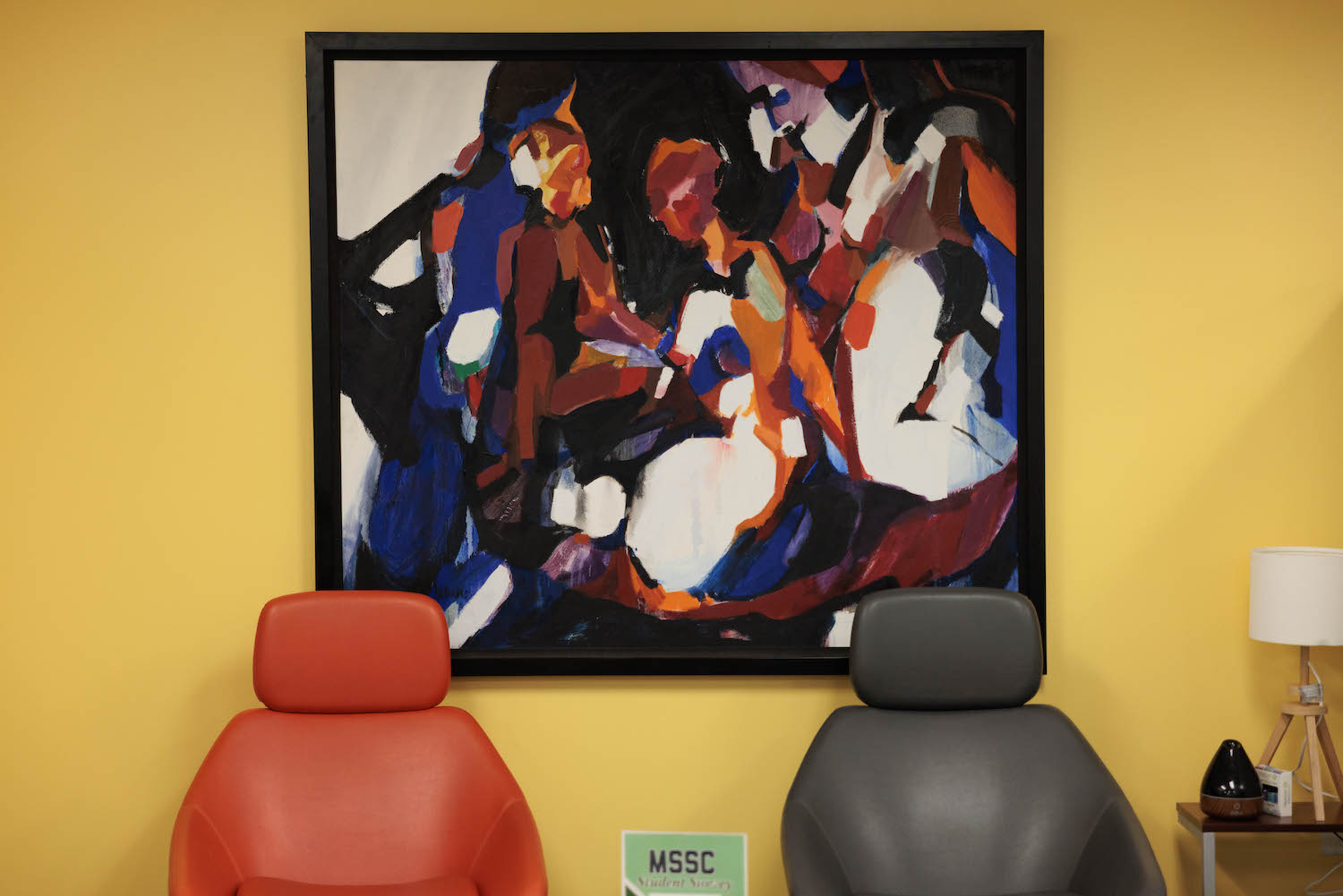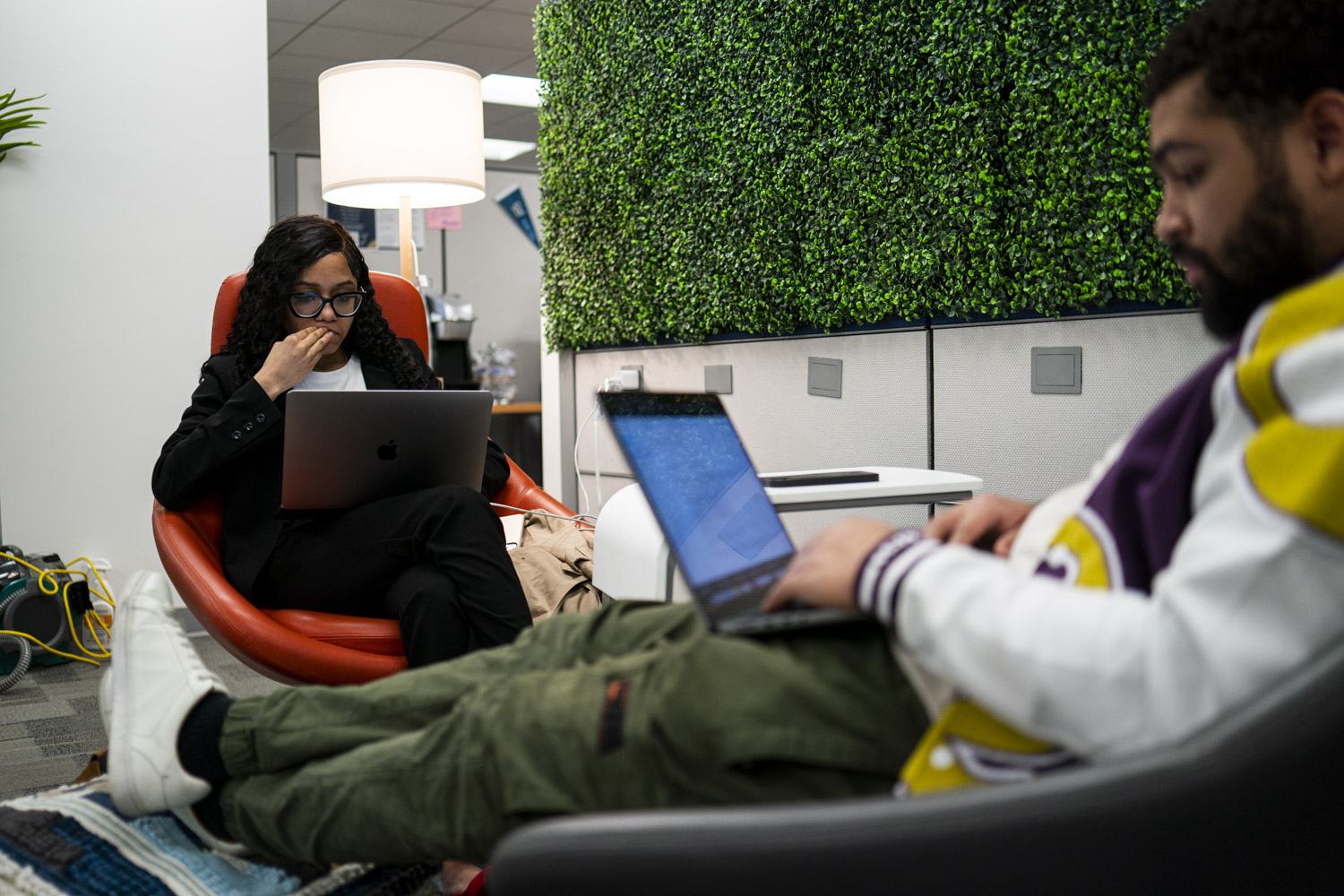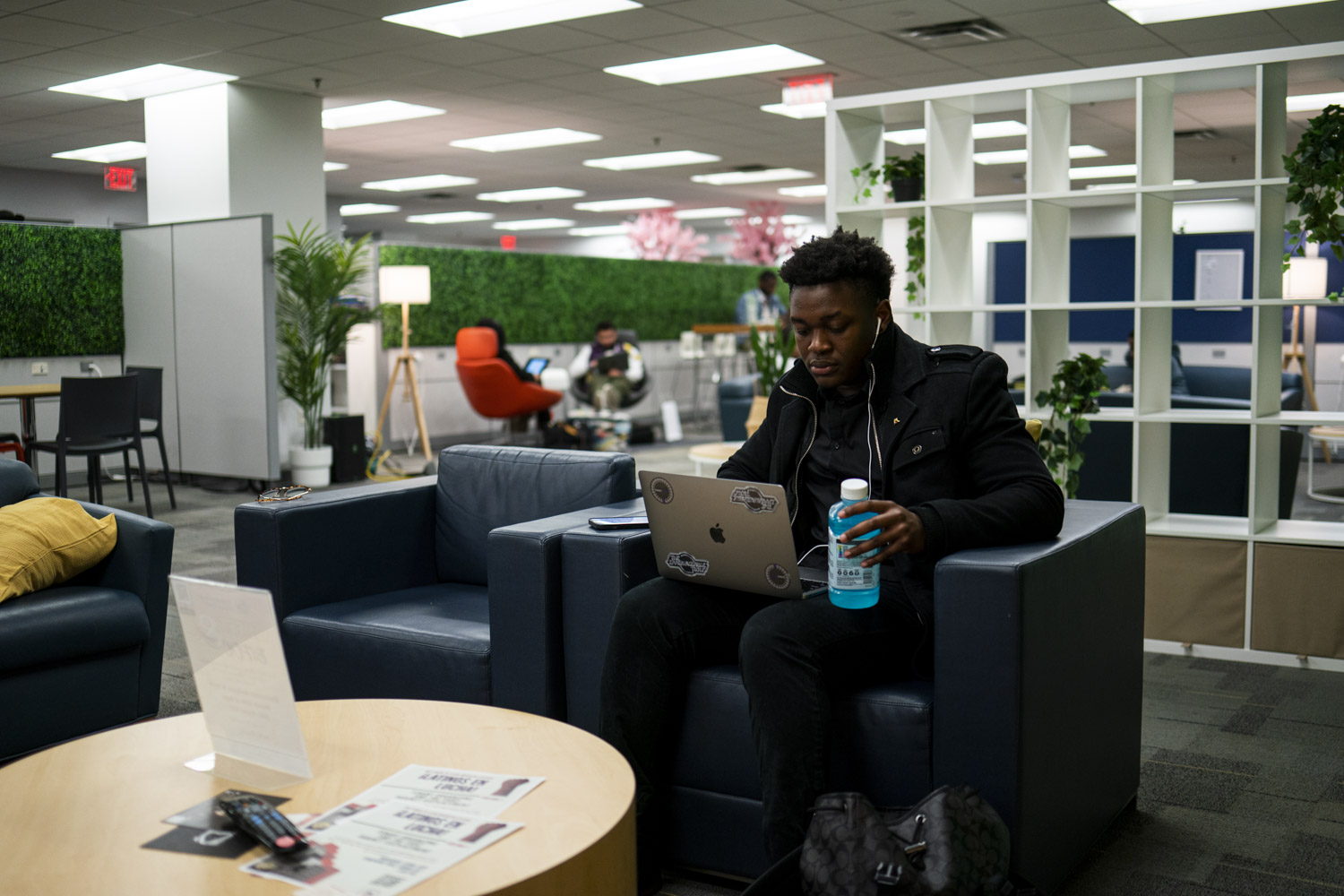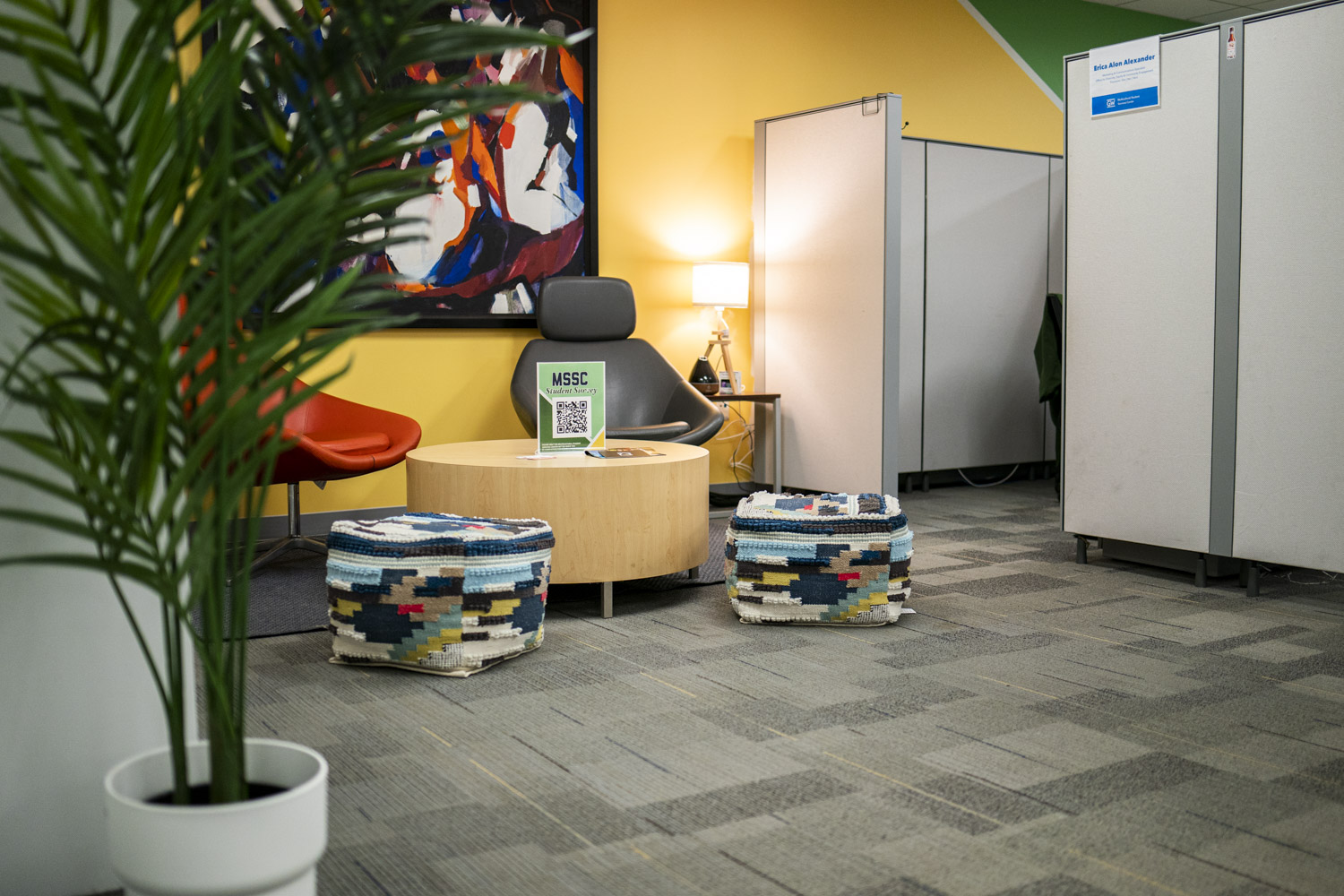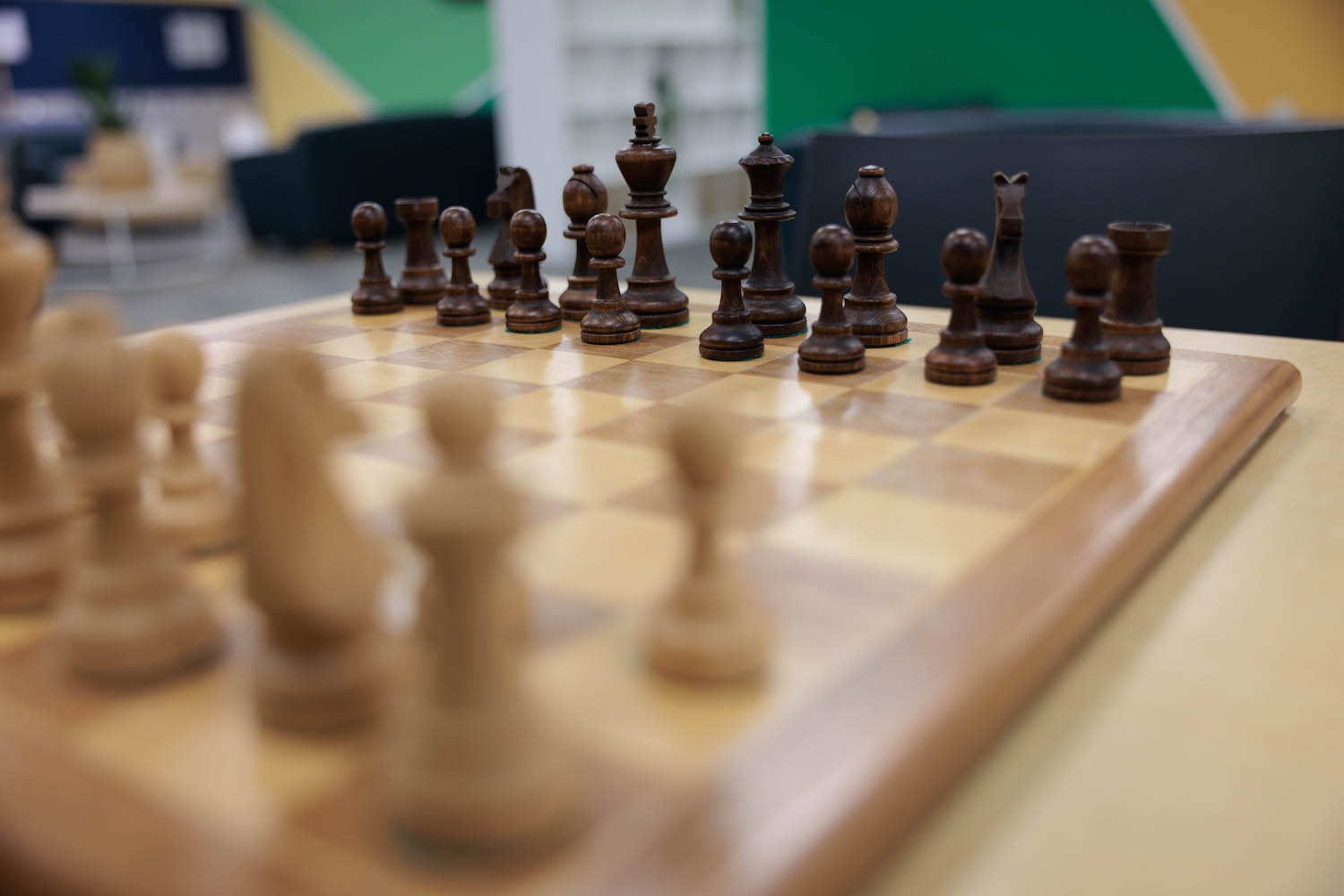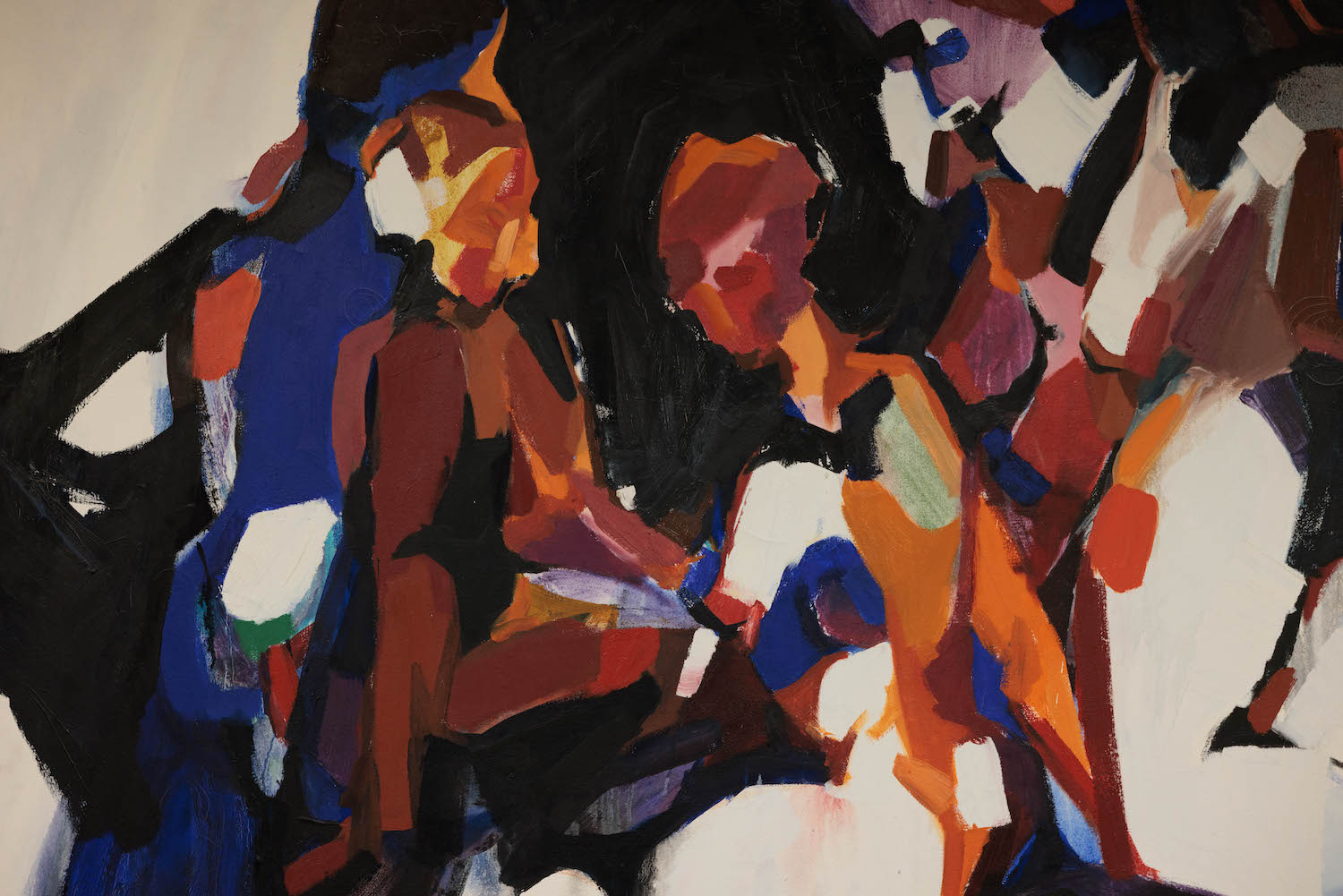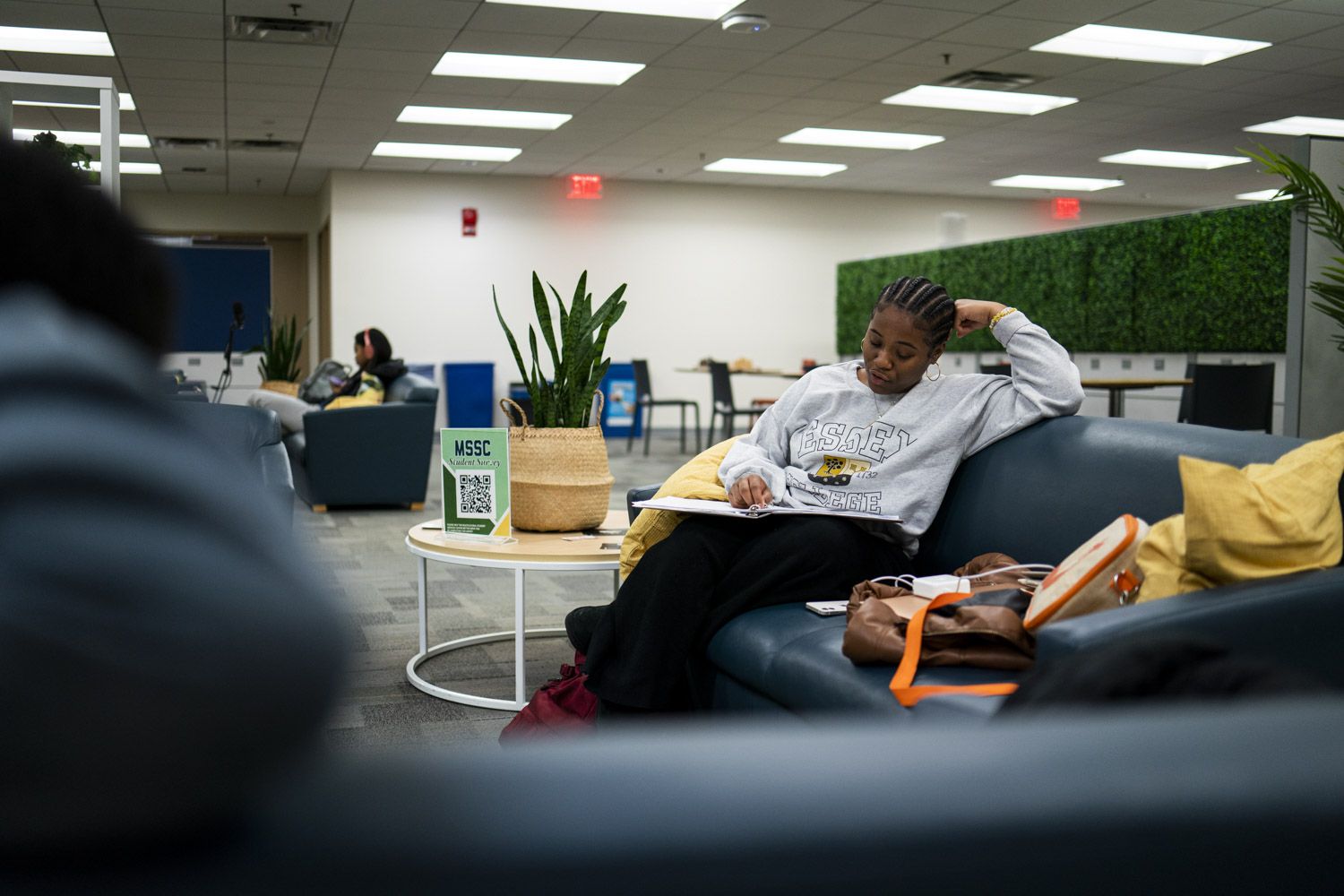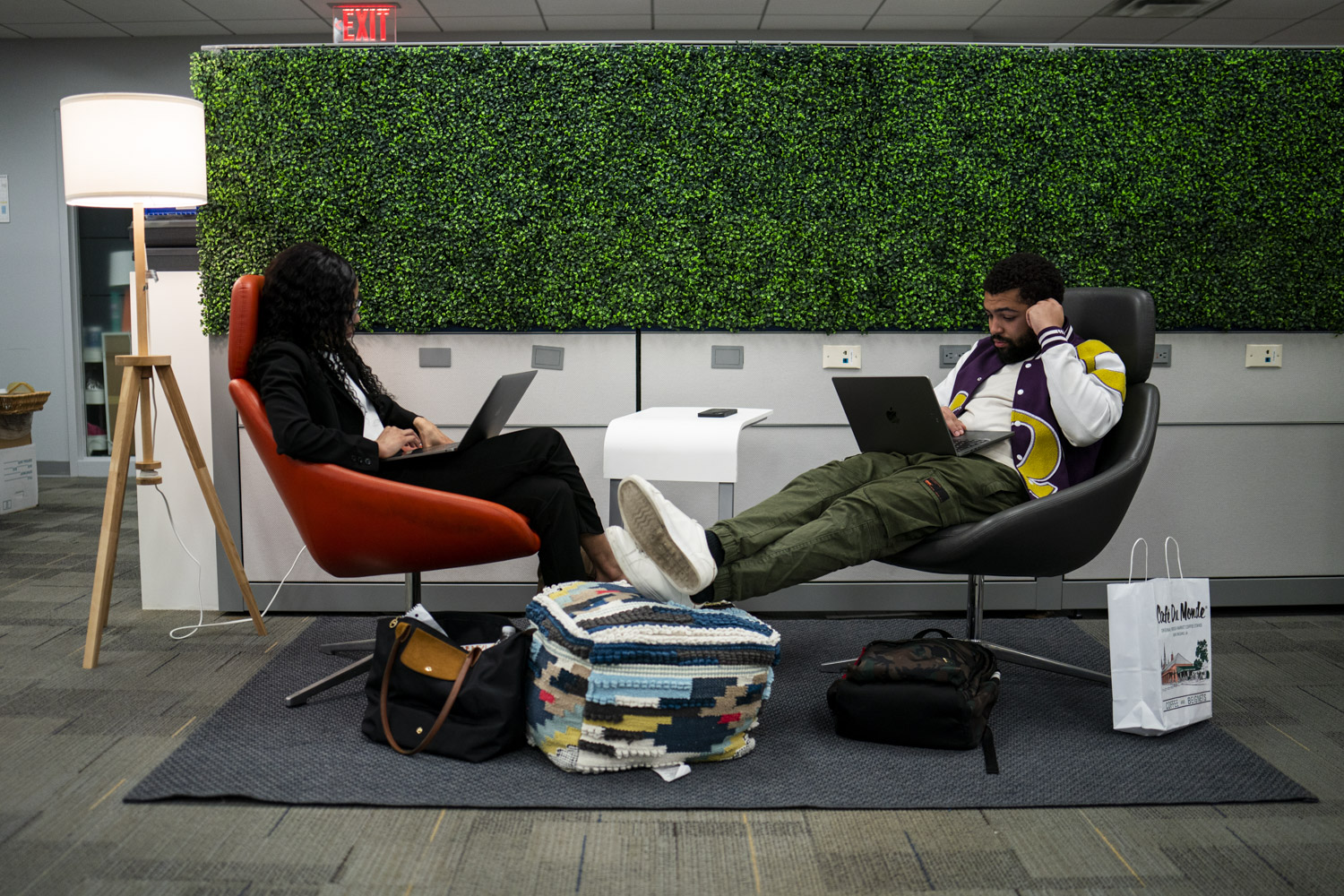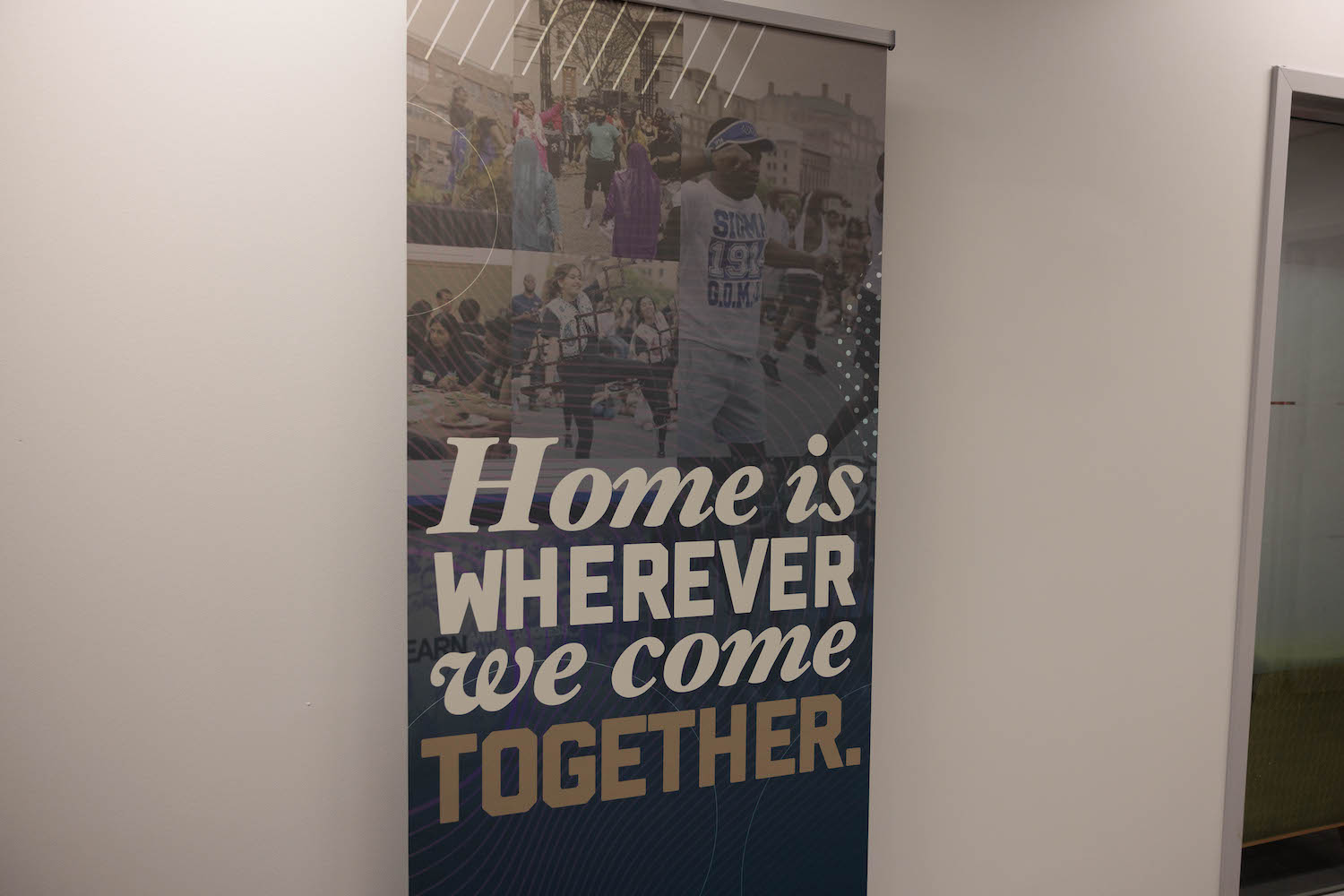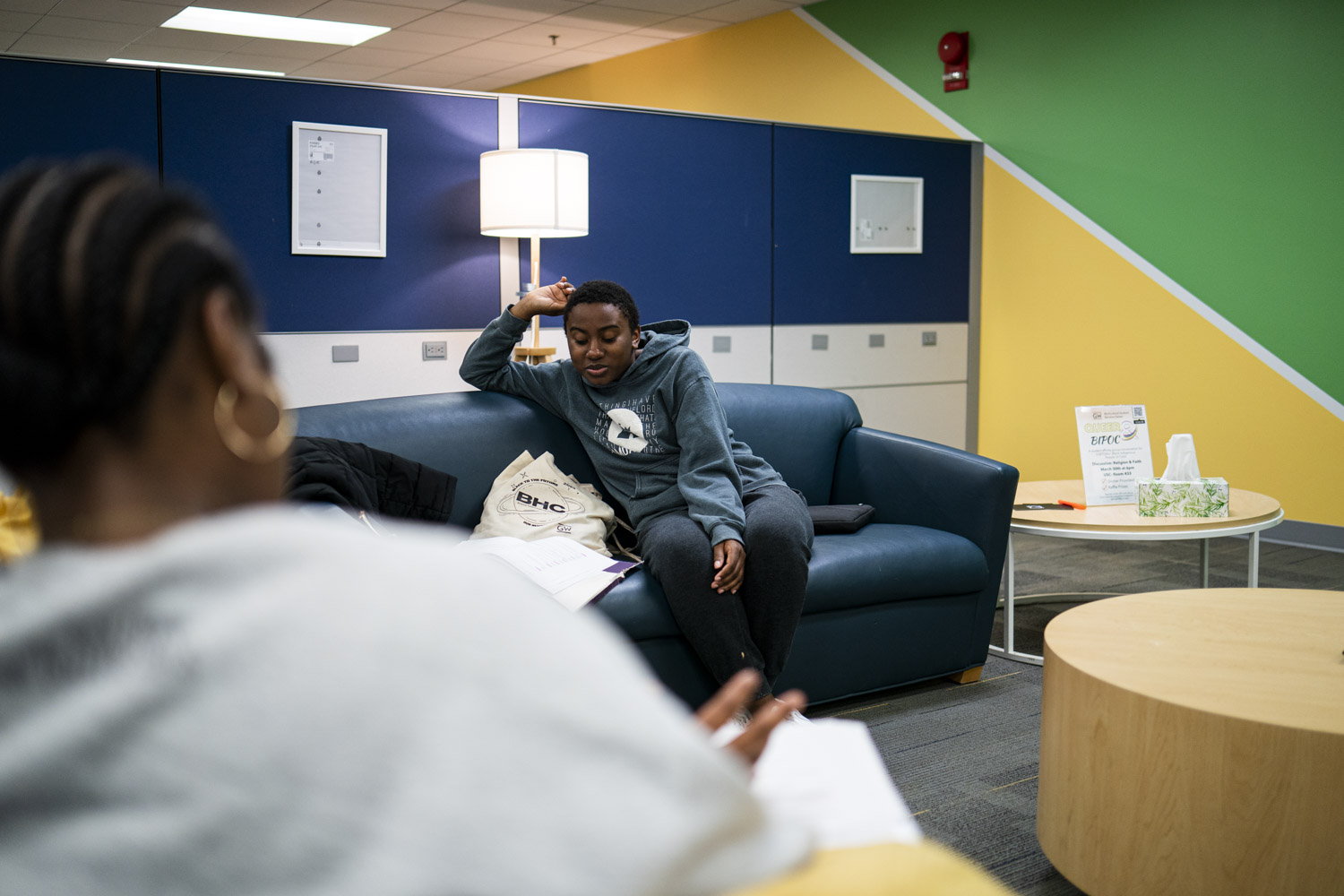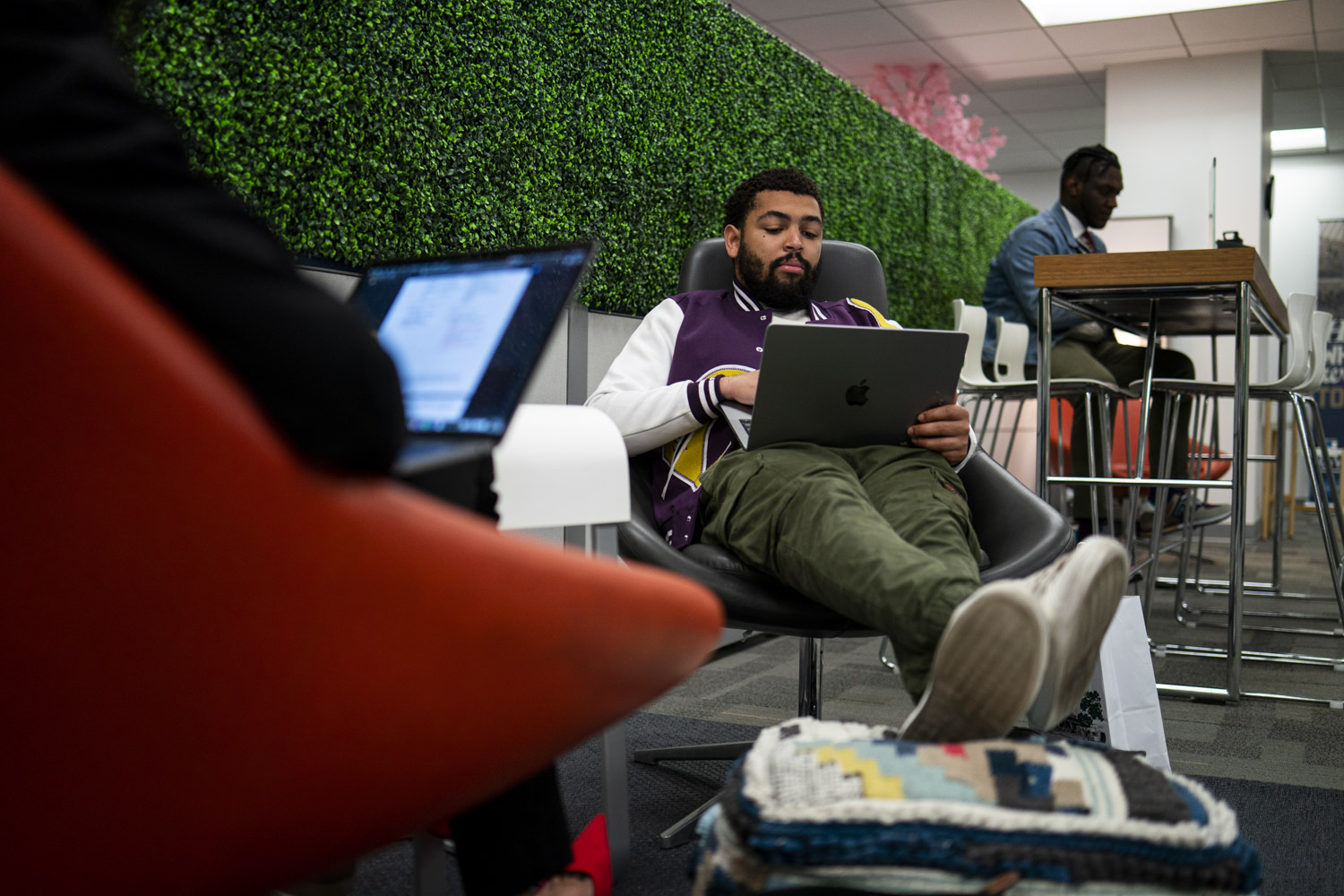Since the 1960s, the Multicultural Student Services Center (MSSC) has provided a home away from home for George Washington University students with underrepresented and historically underserved identities. Recently, the MSSC began an exciting new phase: moving to a modernized space on the fifth floor of the University Student Center.
Revamped over Spring Break, the current flexible, multi-purpose location includes gathering areas for community conversation; quiet corners for studying, relaxing and recharging; and technological amenities such as podcast recording equipment.
A wall painted with bright geometric shapes backs the length of the new space, across from a “green wall” that aims to bring life, light and brightness into the MSSC. Colorful poufs and comfortable chairs provide seating. A vibrant, oversized canvas painting overlooks the relaxation area, originally hanging on the wall in the former MSSC townhouse. The fifth-floor space holds many possibilities for student- and community-driven evolution, Pickett said.
“We want to ensure that this space feels like home—that it’s comfortable, that it’s inviting, that it gives students a space both to gather in community or to take off and do some studying or meditate, or pray privately,” Pickett said. “We also want this to be a space that showcases who the MSSC is, where we’ve been and where we are. What is the journey of students who have navigated GW with a particular identity? How do we highlight that? We really see this as a space that is truly multi-purpose—that fits people’s unique individual needs and also brings us together collectively.”
Jordan Shelby West, associate vice provost for diversity, equity and community engagement, noted that moving from the townhouse is “bittersweet” because it was filled with so much history. “Most importantly, the new space in the University Student Center allows the MSSC to be physically accessible to all students seeking support, community, programming and more,” West said.
The MSSC has been a place of fellowship and community for senior Gianna Cook since her first year at GW, when previous director Michael Tapscott saw her sitting alone after Convocation and invited her inside to meet other students. “Ever since then, it’s definitely been a home for me on campus,” said Cook, who is now president of the Black Student Union.
Cook said she appreciates the new space’s blend of private and communal space, which gives students “autonomy” but also the opportunity to join conversations that call to them. “I really like the way the space is set up,” she said.
Students and the wider community should “know that this is a space for them, and anyone is welcome,” Cook said.
Fellow senior Hope Ledford, an MSSC student staffer who has also been involved with the center throughout her time at GW, agreed.
“I think the beauty of the MSSC is that it means something different to everyone, and for me, it means community,” said Ledford, who will remain at GW after graduation as she works toward her master’s degree in public policy. “Oftentimes as students we’re so busy moving through our day, going to classes and doing internships, all our different jobs and responsibilities. But every time I come to the MSSC it kind of feels like time just stops. I get to unwind and connect with other people who are both similar and very different from me and also get to know other community members at GW…It’s just such a prosperous space to facilitate connections.”
A new director
Pickett, who joined GW in January, is deeply conscious of the importance of a strong, supportive community rooted in history. He spent his childhood in the thousand-person town of Beulaville, North Carolina, the youngest son of a tight-knit family that spanned five generations. Pickett remembers working in the garden alongside his great- and great-great grandmothers.
“I feel a deep connection to history, even to my ancestors who are not here,” he said.
Pickett attended Winston-Salem State University, a historically Black institution in North Carolina, where he threw himself into multiple leadership roles across campus and saw firsthand, again, the importance of community support.
“I learned a lot about myself and identity as a Black man and what that meant in terms of navigating the world,” said Pickett, whose faith was important in his upbringing and is now rooted in standing with society’s most oppressed.
Pickett received a master of divinity degree from Duke University, where he encountered Black liberation theology and, through that, other liberatory frameworks, including queer and womanist theologies.
Pickett came to GW from the University of Dayton, where he served as director of multi-ethnic education and development, led the Multi-Ethnic Education and Engagement Center (MEC), Dayton’s equivalent of the MSSC. There, similarly to GW, Pickett said students repeatedly shared that the MEC was a “home” within the institution. As the MSSC transitions into its new physical space, Pickett and his staff feel both the challenge and the excitement of creating that home and shaping the future of the MSSC with intentionality.
“The idea of ‘home’ is not without issue, and support at home is complicated for a lot of people,” Pickett said. “But what would it look like to really create a home in the way that we would have wanted it to be growing up? To ensure that love and care and intentionality and inclusion and all those things were embedded in this space? I want students to come in and it feels like whatever is your most ideal perspective of home.”
An evolving space
The space’s welcoming ambience, its flexibility and amenities are the result of significant effort by MSSC staff, students and collaborators within the Office of Diversity, Equity and Community Engagement (ODECE) and the Division of Student Affairs. Their work “makes the space what it is” for the students who gather there, student Cook said.
With a full-time staff of three leading from an intersectional approach, the MSSC is grounded in three core areas of focus—LGBTQIA+, race and ethnicity and religion, faith and spirituality. The MSSC thrives on partnerships and support from across the community, and engagement from students, faculty, staff, alumni and local partners.
The MSSC has a responsibility to balance privacy and communality, engagement and refuge, challenge and relaxation. As Pickett puts it, “There are times when the living room is open, and whoever wants to come in and engage should feel free to do that—and then there are also times where we need to have a more intimate family meeting.”
The physical space of the MSSC will continue to evolve over the next two years, in partnership with the Division for Student Affairs and Campus Planning.
“The future of MSSC will include dynamic programming, meeting, studying and gathering spaces for students, classes, events and organizations,” West said. “There will be dedicated space to honor and amplify the three current areas of focus for the MSSC—race, ethnicity and culture; gender and sexuality; religion, faith and spirituality. There will be space given to creatives making podcasts, for example, and individuals who seek prayer, meditation, sensory space, development, healing and growth.”
“History will be archived, preserved and available on display and electronically,” West said. “Murals, pieces of art, pictures of GW students and quotes will wrap the floor in a way that shows students they are here, and we see them. And there will be names given to each space to remind students that this is their home–from the kitchen to the living room and more, home will be wherever we gather in the MSSC.”
While enhancements continue, Pickett and his team are using the new space as an opportunity to revitalize the MSSC’s mission, values and programming. Students’ educational experiences have now been shaped by the COVID-19 pandemic, and their needs and priorities may differ from those of previous generations.
More than anything, Pickett said, he’s excited to work with students to make the MSSC even more effective as the physical and emotional home it has been to so many for so long.
“Really being able to engage with students, to hear from students as we’re continuing to consider how we reshape and revamp this space, is what I’m looking forward to,” he said.


